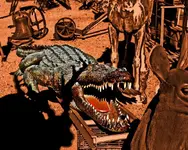Hey all, found this thread and since I'm from CT it peaked my interest Did a little searching and found a few things. I'm not on either side of the fence here, just posting some info I found.
1. This I copy and pasted from some other thread :
REGARDING THE EAST GRANBY TREASURE
This is another of my statement that was stolen by a crook.
The article GOLD CACHE is wrong. FLOYD: "I hope you print my story, because many of your readers made comments and are wasting their time and money looking for it."
Here we go again. I am 64 years old and have lived in Connecticut for most of my life. I became a coin collector in 1964. After seeing many ads for metal detectors in COIN WORLD, I bought a Whites detector and that got it all started. Since that time, including the latest LOST TREASURE magazine, I had read the story of 13 wagon loads of gold coin loaned from France that got robbed at Bates Tavern. Unlike many authors, I did a lot of research, including interviewing William Bates, who was an old man. He, like many people, is a story teller. He told me the story was true and that the boxes were buried near a stream, because the digging was easy.
Years later I spoke to his son-in-law who lives in the tavern, with his wife. He had to be in his sixties. I asked him if William really believed the story. He told me that the Bates had never heard of the story until they read the letters from a woman to the Hartford Cournat newspaper in 1951.
Remember: Captain Lemuel Bates died at 91 years of age. I hope to live that long. He lived in the tavern until he died. That means he would tell his children, who would tell their children the story. Most people believe that stories in treasure magazines are false. The coins were never found, and never will be, because the story is false. The treasure story writer for LOST TREASURE magazine states that Richard H. Phelps wrote a book claiming that Henry Wooster, a Tori, was involved and wrote a letter to his mother stating that he had helped rob the wagons with the coins. Wrong ! Phelps, who lived in East Granby, never mentioned that story. He wrote that Henry had robbed a house, with his friends, and went to England and came back after the war. The article in the magazine also states " in 1951 a Hartford woman wrote a series of articles about the heist." If the story was true,then it would have been in the local papers at the time. I also asked a woman who lived in East Granby all of her life, why she didn't write about the treasure in her East Granby history book. She said the story was false. If you find the coins, just send me a picture. Every time the story is printed, many new people show up at Bates Tavern looking for the treasure. You would think that someone would have found the coins since 1951---if the story was true. I'd be grateful if anyone has any true stories of treasure in Connecticut. Best of luck to you all.
2. This is a link to an article I found mentioning the above Henry Wooster. Interesting reading whether you believe the story of the treasure or not.
http://www.americanheritage.com/articles/magazine/ah/1967/2/1967_2_40.shtml
Good luck.





